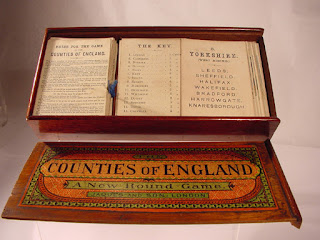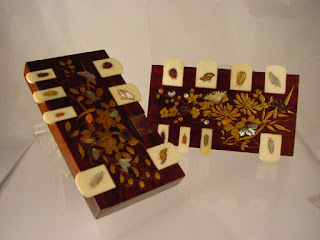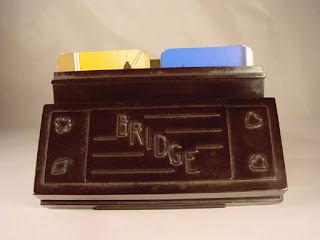The 'Twixmas' period is the perfect time for having fun with family, when many of us dig out the packs of cards and challenge each other to a game. So we thought we'd have a root in our Toys and Games collection for some ideas to pass the winter evenings. From traditional trick-taking and trumps, to more obscure offerings, we found some real aces.
We are all familiar with the humble playing card thanks to a
long tradition dating back to the 14th century when playing cards
first arrived in Europe. They most probably came to the West via India and
Egypt from China, where they were likely invented along with the pioneering of
paper and printing. Originally lavishly hand illustrated, playing cards were
the preserve of the rich until advances in printing technology made them
cheaper and more readily available to the masses. The backs of cards were left
blank until the 19th century. They were first decorated to avoid
cheating by marking cards but manufacturers soon saw the advertising potential.
Playing cards are often now produced as promotion items like this pack
advertising Wakefield based brewery, Beverleys.
 |
| Playing cards advertising Beverleys Beers, John Waddington Ltd, c. 1950s - 1970s |
The four suits we are so familiar with in Britain today
originate from France. The global popularity of whist and bridge meant the
Anglo-French suitmarks became the international standard, although national
variations remain.
 |
| Trump indicator used in whist. Whoever played the highest scoring clubs card would have won the trick in this round. |
 |
| Bridge set in Bakelite case, Seaforth, 1930s - 1950s |
There are countless games to be played with a standard 52
card deck, whether single player or for teams or large groups. But we have also
found a variety of other card decks in the collection, some educational and
some a little more frivolous.
 |
| Counties of England, Jacques & Sons |
Counties of England is a geographical variation on Happy
Families. Players compete to complete a county by collecting all the appropriate
town cards. The winner collected the most counties. Of course, the real victor
is whoever collects Yorkshire!
Beat Your Neighbour is a catch and collect game- the aim is
to claim all your opponents’ cards. Without looking at their hand, each player
turns over a card in turn. If someone plays a Put card, the next player has to
surrender that number of cards. If they do not turn over a Put card themselves,
the previous player claims the pile. There are many varieties of Beat Your
Neighbours card, each with different themed illustrations.
 |
| Snip Snap, Stanfield Holdings, 1970s |
Snip-Snap is a matching game with a difference. It was
designed to help the British adapt to the new decimal currency system
introduced in 1971. Players won cards by being the first to spot pairs. They
would shout ‘Snip’ for a matching pair of decimal coins or ‘Snap’ for two
identical old currency cards. When a pre-decimal card is matched with its new
currency equivalent, players must declare, ‘Snip-Snap!’ whilst being careful
not to call an incorrect pair and be forced to forfeit a card to each of their
opponents.
 |
| Pit, John Waddington Ltd |
Pit is a trading game mimicking a corn exchange. The cards
represent different crops (9 cards for each of the 7 grains) and players vie to
be the first to complete a full set. Players trade cards with each other,
declaring the number of cards they wish to swap but not revealing the
commodity. The traders all shout out their offers at once resulting in a high
energy, high volume competition. Each complete set has a different points value
and the victorious trader is the first to reach 500 points.
There are no winners as such in this game - rather the objective is not to be the Muggins, the last player left holding any cards. There are four packs of cards numbered 1-25 that are shuffled and shared out by the dealer. The aim is to reunite the cards into their four groups. Each player takes it in turns to discard as many cards as they can but cards must be played in numerical order, either ascending from 1 or descending from 25. If you don't have the next number in the sequence, you must instead accept a card into your hand from each of your opponents.
Muggins promises 'roars of laughter'. As a nation, we have been enjoying card games for centuries. Which is your favourite? Let us know what you've been playing these holidays in the comments and over on social media.
 |
| Muggins, R&S, early 20th century |
Muggins promises 'roars of laughter'. As a nation, we have been enjoying card games for centuries. Which is your favourite? Let us know what you've been playing these holidays in the comments and over on social media.
If you'd like more inspiration for games to enjoy this Christmas, check out Old Fashioned Fun and don't forget you can browse our Toys and Games collection online.




No comments:
Post a Comment
We would love your comments - though they may take a day or two to appear.